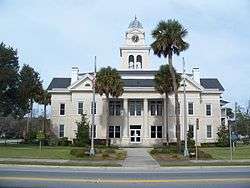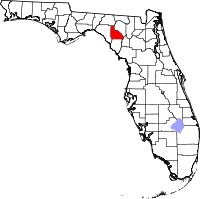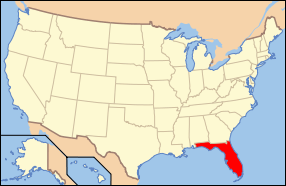Lafayette County, Florida
| Lafayette County, Florida | |
|---|---|
 Lafayette County Courthouse | |
 Location in the U.S. state of Florida | |
 Florida's location in the U.S. | |
| Founded | December 23, 1853 |
| Named for | Marquis de Lafayette |
| Seat | Mayo |
| Largest town | Mayo |
| Area | |
| • Total | 548 sq mi (1,419 km2) |
| • Land | 543 sq mi (1,406 km2) |
| • Water | 4.5 sq mi (12 km2), 0.8% |
| Population (est.) | |
| • (2015) | 8,663 |
| • Density | 16/sq mi (6/km²) |
| Congressional district | 3rd |
| Time zone | Eastern: UTC-5/-4 |
| Website |
www |
Lafayette County is a county located in the state of Florida. As of the 2010 census, the population was 8,870,[1] making it the second-least populous county in Florida. The county seat is Mayo.[2] Lafayette County is a prohibition or entirely dry county.
History
Lafayette County was created on December 23, 1856 from part of Madison County. At the time it comprised all the area of present-day Lafayette and Dixie counties. The County was named in honor of the Marquis de Lafayette, the French general who rendered assistance to the Continental Army in the American Revolutionary War.[3] The famed Suwannee River forms the entire eastern boundary. The county courts first met at the home of Ariel Jones near Fayetteville. The county seat was New Troy until the court house burned down on New Year's Eve, 1892. It was moved to Mayo in 1893, and Mayo is currently Lafayette's only incorporated town. The moving of the courthouse was the end for New Troy. The Gainesville Sun states that houses were dismantled for their timber and bricks, hardwoods replaced the fields, steamboat traffic ended in 1899, and the ferry closed in 1917. In 1921 the lower part of the county was removed to create Dixie County.
Historic sites
Historic sites in Lafayette County include:
- The Hal W. Adams Bridge built in 1947 across the Suwannee River 3 mi (5 km) north of Mayo. It was Florida's first suspension bridge.
- The (second) Old Lafayette County Courthouse, built in 1893-1894, now an inn.
- The current Lafayette County Courthouse built in 1908.
Geography
According to the U.S. Census Bureau, the county has a total area of 548 square miles (1,420 km2), of which 543 square miles (1,410 km2) is land and 4.5 square miles (12 km2) (0.8%) is water.[4]
Adjacent counties
- Suwannee County - east
- Gilchrist County - southeast
- Dixie County - south
- Taylor County - west
- Madison County - northwest
Demographics
| Historical population | |||
|---|---|---|---|
| Census | Pop. | %± | |
| 1860 | 2,068 | — | |
| 1870 | 1,783 | −13.8% | |
| 1880 | 2,441 | 36.9% | |
| 1890 | 3,686 | 51.0% | |
| 1900 | 4,987 | 35.3% | |
| 1910 | 6,710 | 34.5% | |
| 1920 | 6,242 | −7.0% | |
| 1930 | 4,361 | −30.1% | |
| 1940 | 4,405 | 1.0% | |
| 1950 | 3,440 | −21.9% | |
| 1960 | 2,889 | −16.0% | |
| 1970 | 2,892 | 0.1% | |
| 1980 | 4,035 | 39.5% | |
| 1990 | 5,578 | 38.2% | |
| 2000 | 7,022 | 25.9% | |
| 2010 | 8,870 | 26.3% | |
| Est. 2015 | 8,663 | [5] | −2.3% |
| U.S. Decennial Census[6] 1790-1960[7] 1900-1990[8] 1990-2000[9] 2010-2015[1] | |||
As of the census[10] of 2000, there were 7,022 people, 2,142 households and 1,591 families residing in the county. The population density was 13 people per square mile (5/km²). There were 2,660 housing units at an average density of 5 per square mile (2/km²). The racial makeup of the county was 79.27% White, 14.37% Black or African American, 0.71% Native American, 0.13% Asian, 0.01% Pacific Islander, 4.30% from other races, and 1.21% from two or more races. 9.14% of the population were Hispanic or Latino of any race.
There were 2,142 households out of which 34.00% had children under the age of 18 living with them, 59.20% were married couples living together, 9.20% had a female householder with no husband present, and 25.70% were non-families. 22.00% of all households were made up of individuals and 10.10% had someone living alone who was 65 years of age or older. The average household size was 2.66 and the average family size was 3.06.
In the county the population was spread out with 21.70% under the age of 18, 10.70% from 18 to 24, 34.00% from 25 to 44, 21.30% from 45 to 64, and 12.40% who were 65 years of age or older. The median age was 35 years. For every 100 females there were 148.80 males. For every 100 females age 18 and over, there were 157.80 males.
The median income for a household in the county was $30,651, and the median income for a family was $35,020. Males had a median income of $25,030 versus $22,007 for females. The per capita income for the county was $13,087. About 12.90% of families and 17.50% of the population were below the poverty line, including 23.70% of those under age 18 and 17.30% of those age 65 or over.
Politics
| Year | Republican | Democratic | Other |
|---|---|---|---|
| 2012 | 78.3% | 20.2% | 1.5% |
| 2008 | 79.3% | 19.0% | 1.7% |
| 2004 | 74.0% | 25.4% | 0.6% |
| 2000 | 66.7% | 31.5% | 1.8% |
Parks
Parks in the county include Lafayette Blue Springs State Park and Troy Springs State Park, both accessible to the Suwannee River.
Library
The Lafayette County Public Library is part of the Three Rivers Regional Library System, which also serves Gilchrist, Dixie, and Taylor counties.
Communities
Town
Unincorporated communities
See also
References
- 1 2 "State & County QuickFacts". United States Census Bureau. Retrieved June 14, 2014.
- ↑ "Find a County". National Association of Counties. Retrieved 2011-06-07.
- ↑ Gannett, Henry (1905). The Origin of Certain Place Names in the United States. Government Printing Office. p. 178.
- ↑ "US Gazetteer files: 2010, 2000, and 1990". United States Census Bureau. 2011-02-12. Retrieved 2011-04-23.
- ↑ "County Totals Dataset: Population, Population Change and Estimated Components of Population Change: April 1, 2010 to July 1, 2015". Retrieved July 2, 2016.
- ↑ "U.S. Decennial Census". United States Census Bureau. Retrieved June 14, 2014.
- ↑ "Historical Census Browser". University of Virginia Library. Retrieved June 14, 2014.
- ↑ "Population of Counties by Decennial Census: 1900 to 1990". United States Census Bureau. Retrieved June 14, 2014.
- ↑ "Census 2000 PHC-T-4. Ranking Tables for Counties: 1990 and 2000" (PDF). United States Census Bureau. Retrieved June 14, 2014.
- ↑ "American FactFinder". United States Census Bureau. Retrieved 2011-05-14.
External links
| Wikimedia Commons has media related to Lafayette County, Florida. |
Government links/Constitutional offices
- Lafayette County Board of County Commissioners
- Lafayette County Supervisor of Elections
- Lafayette County Property Appraiser
- Lafayette County Sheriff's Office
- Lafayette County Tax Collector
Special districts
Judicial branch
- Lafayette County Clerk of Courts
- Public Defender, 3rd Judicial Circuit of Florida serving Columbia, Dixie, Hamilton, Lafayette, Madison, Suwannee, and Taylor Counties
- Office of the State Attorney, 3rd Judicial Circuit of Florida
- Circuit and County Court for the 3rd Judicial Circuit of Florida
 |
Madison County |  | ||
| Taylor County | |
Suwannee County | ||
| ||||
| | ||||
| Dixie County | Gilchrist County |
Coordinates: 29°59′N 83°11′W / 29.99°N 83.18°W
